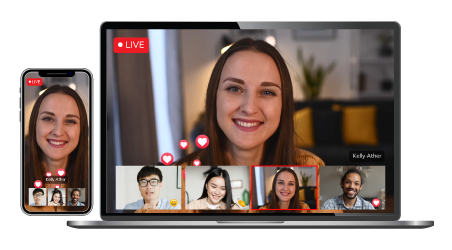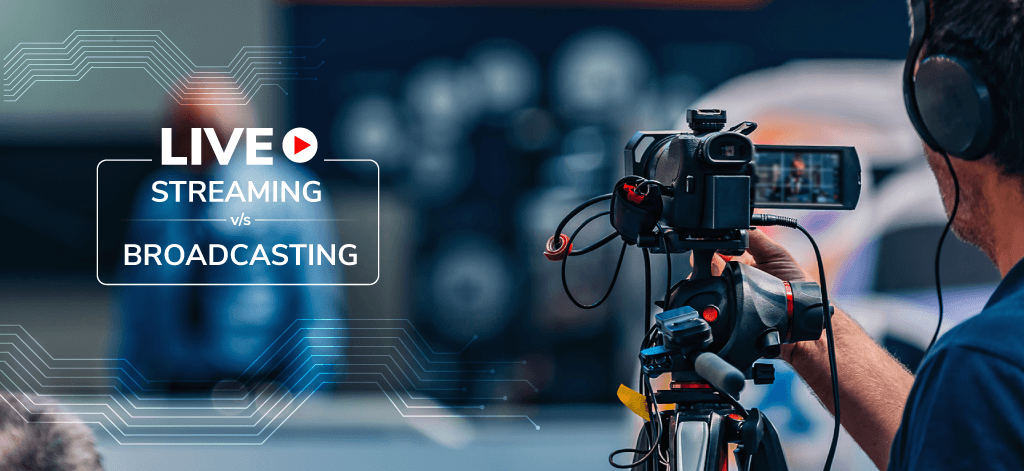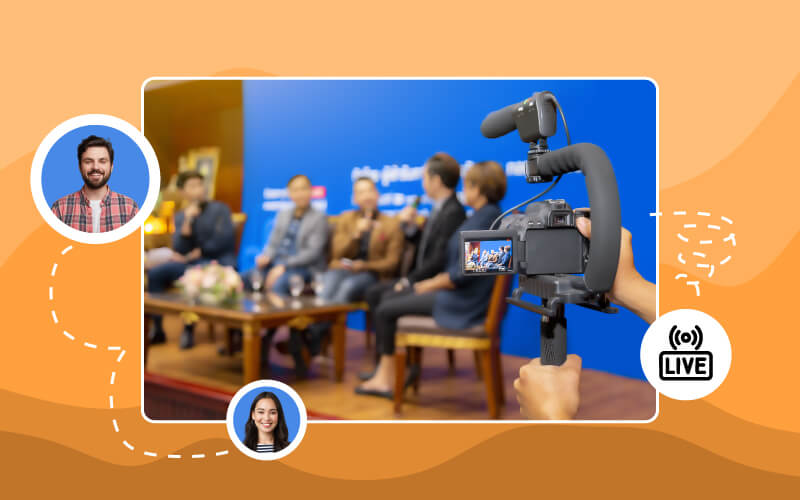Today, we consider the world to be shrinking as we see the ease with which communication happens across the boundaries placed by huge distances, different ethnicities and various socio-economic statuses. Out of the many mediums of mass communication that made this possible, digital media has played a major role in recent years.
The advent of the internet and the subsequent wave of online methods of dispersal of information have impacted the world in ways that are beyond comprehension. Therefore, it is not really surprising how fast live streaming has shot up as a preferred choice of personal and professional communication when the occasion calls for it. Educational endeavours or events, business meetings, conferences, product launches, private events and a sundry of tasks are assisted by the use of the best live streaming solutions available.
Connect with the Industry's Most Experienced
Live Streaming Service Providers.

In fact, the use of live streaming has become so familiar and easily accessible in our daily lives that the word itself has become an umbrella term in the everyday lingo of people far and wide. Viewing any live video is considered ‘live streaming’ despite some distinct differences between the processes. Even live broadcasting videos have started to come under what people generically described as live streaming videos. While both of these are very similar in the fact they work in real-time, they are also very different too. Let’s expand on this to understand both of these better.
What is a Live Broadcast?
So what is the live broadcast meaning? The term broadcast defines how many viewers can watch the same live video at the same time. The technical working behind this shows a single signal being received by many receivers simultaneously. The devices get these broadcast signals almost at the speed of light. Since the frequency of the broadcast signal is set, many receivers can tune in to it. You see this phenomenon in radio and television broadcast regularly. While in both these cases, the power usage and often enough, an external antenna is used; this is not the case with all the devices which receive broadcast signals.
Today, such analogue methods of getting the signal can be replaced with digital broadcasting methods. In fact, a lot of countries around the globe have banned the use of analogue broadcasting. So if you are watching a live match or live show on TV, you may be consuming real-time visual content but you are not actually live streaming.
Benefits of live broadcasting
It’s all about reaching out to a larger audience; think of it as your TV station where you may reach a worldwide audience with live or on-demand content.
- It’s now live! A message, announcement, or performance can be sent immediately as it happens.
- There are no time restrictions; events can go as long as necessary because they are not constrained by TV scheduling or DVD/video length.
- Webcasting programming is less expensive than employing satellites or other for-profit television delivery systems. Why pay money to broadcast your event on TV to a limited geographic region when you can do it for far less money online to everyone on the planet?
- Users can participate in the event through integrated voting, event registration and conversation, or by accessing information and online connections related to the streaming media event.
- By email, phone call-ins, or even video conferencing, you may ask live questions of the speakers.
- You may easily make money by charging people to see your content. The web is geared up to handle simple credit card purchases known as “pay as you view.”
- Viewers may choose to watch event highlights on-demand, utilizing pre-recorded footage, and genuine “video on demand,” whenever they choose, wherever in the globe.
- By requiring users to register or use passwords, we may either limit access to content to known users or collect crucial marketing data from your audience.
- Event planners may employ streaming media to attract people to their website, and it is simple to include powerful branding messaging into the viewing experience.
- Make sure that everyone is hearing the same message from the same source by speaking with one voice. Dispel misunderstandings and rumors.
Connect with the Industry's Most Experienced
Live Streaming Service Providers.

What is Live Streaming?
Unlike live broadcasting, live streaming works on a one-to-one basis where different signals are sent to different receivers simultaneously. What is Live streaming meaning? Live streaming is the transmission on video over the internet in real-time without being recorded and stored. The one hosting the stream sends out separate signals to various devices regardless of the fact the viewers are tuning in to watch the live video at the same time. There are several Live streaming platforms, including social media sites and private websites. If different people view the same live Youtube video, for example, all of them watch it through different pathways determined by the various packets of the same frame and the different devices being used. The many different variables involved in the completion of this task matter a lot.
Benefits of live streaming
Remain prominent in your audience’s mind
You may simply stay in touch with everyone who is interested in your brand, no matter where they are, using streaming solutions. Consider broadcasting live on YouTube, Facebook, or LinkedIn Live. In that situation, notifications are sent to your followers each time you broadcast live. At the same time, live video is preferred above other types of content by some social network search engines. Maybe this is the case since live streaming is watched up to three times longer than on-demand content.
Connect with the Industry's Most Experienced
Live Streaming Service Providers.

Amplify brand awareness
Live events are a fantastic way to network and create new leads for your company. To reach more consumers, you may even collaborate with associate businesses and online influencers.
Increase brand loyalty and trust
Customers desire a strong sense of identity with the businesses they support. By interacting with them via live video, you may provide them with experiences that will increase their knowledge, appreciation, and trust in you and your business. Your ideal clients will return if you offer them useful content like sneak peeks, lessons, or instructional materials that suit their demands.
Develop your authority and thought leadership in your industry
Regular live broadcasts aimed at decision-makers can help you get attention and establish your authority in your industry. Your brand will gain credibility, internet traffic will increase, and you’ll develop deep connections with your consumers when subject-matter experts from your business contribute creative ideas and solutions to issues affecting your sector.
Increase the number of sincere possibilities for interaction
On-demand video material has its role in marketing, but live broadcasts have a higher level of authenticity. There are possibilities for immediate feedback, presenters are a little more authentic, and mistakes happen. Additionally, you can humanize your business and increase viewer engagement by using a live connection, live chat, and Q&A sessions. When doing so make sure to use stream transcoding to ensure compatibility across different devices and internet connections, providing a seamless viewing experience for your audience.
Extend the reach of your event beyond local areas
Geographical restrictions are removed with live streaming events, allowing you to reach a far wider audience. Without making lengthy trip arrangements, you may reach a worldwide audience, saving both you and your clients time and money.
Connect with the Industry's Most Experienced
Live Streaming Service Providers.

Generating more money
Even free events can offer revenue potential. You might charge an admission fee for your live stream event or a subscription cost for continuous participation. You could, for instance, sell branded products, provide digital downloads, and advertise products and services while the event is being streamed live, or you might transform it into paid, on-demand sessions in the future. Sponsorship may also be a choice for big events.
Interact internally with distant and international teams
Live broadcasting isn’t simply for communicating with other people. Relationships may be strengthened, and business culture can be improved. Many businesses utilize live video platforms to organize virtual meetings, training, team-building activities, and collaboration sessions for their staff. These platforms are ideal for global, remote, or hybrid settings.
Reuse content
Most people require repeated exposure to information before it fully sinks in. Share video segments in your sales presentations, regular emails, and social media. Additionally, you may utilize your video content as a springboard to generate new content for infographics, ebooks, and blogs.
Boost conversion
Your leads are already familiar with your products and services when they participate in an online event. They are more likely to make a purchase during or after the event since they have already made time for you and shown an interest in what you have to say. To continue the conversation after you sign out, several corporate live streaming services interact with your marketing tools, such as CRMs.
Benefits of Live Broadcasting
There are similar benefits of live broadcasting as live streaming. But have a bit of difference read to understand;
- Massive Audience Reach: Live broadcasting allows connecting with a massive audience in real time across geographical boundaries and time zones.
- Instant Interaction: With the many added functionalities like; live chats and comments, direct interaction can foster. This overall helps in getting feedback in real-time.
- Authenticity and Transparency: Live broadcasting showcases the user with unedited moments that build credibility and trust compared to post-production.
- Event Coverage: From events, seminars, and conferences, to product launches all kinds of events can be live broadcasted and showcased to virtual or remote audiences to increase overall engagement.
Crisis Management and Updates: In times of any natural calamity or crisis, then live streaming can not be effective as it is dependent on the internet. But live broadcasting allows you to convey information quickly, keeping your audience informed and reassured.
Key Differences Between Live Streaming and Live Broadcasting

Both live streaming and live broadcasting transmit live events to a sizable audience. However, the idea behind live broadcasting is that a single signal is sent over a considerable distance. Live streaming is intended to operate on a one-to-one basis. It involves talking to your clients on your website, responding to their inquiries, and demonstrating the capabilities of your products.
Let’s dissect it. One signal is sent to several receivers as part of the broadcasting process. Radio and television are the two most well-known broadcast media. Broadcasting connections have incredibly fast speeds to accommodate all client requirements. On the other hand, live streaming entails a one-to-one interaction. It concurrently delivers various signals to various users. Even if all of the viewers started viewing at the same moment, the live stream provider will need to transmit distinct signals to each of them.
Though both of them serve the same purpose of communicating information live and in real-time, there are intrinsic differences between these two processes.
Reach
In terms of how much audience they cover, live broadcasting has more viewership by virtue of being a technology that is older than live streaming. Through the years, broadcasting has built a stable format of who watches what. For example, even if you can live stream cricket matches, you would want to watch the live broadcast on TV rather than streaming it.
Engagement
Despite having a larger audience, live broadcasting definitely lags behind in engagement. The primary reason for the same is that broadcasting is a one-way communication that has a passive audience. On the other hand, the channels through which live streaming is done are interactive and encourage engagement and feedback.
Feasibility
Financially speaking, live streaming is far cheaper than live broadcasting. The latter requires expensive equipment to reach its viewers, whereas live-streamed videos easily reach anywhere.
Restrictions
Live streaming videos suffer from fewer restrictions as compared to a live broadcast. Regulations of a country and its media apply on broadcast far more than they apply on any streaming video.
There are many other differences in how both of these work and how they are perceived by the masses that witness it. Due to its two-way quality, live video streaming services are preferred to make an emotional impact and build a connection with the audience. The most prominent example of this is the culture of brands using influencer, bloggers and vloggers to market themselves. The human connection generated through live streams is a very effective part of digital marketing strategies today. Unfortunately, the same is rarely achieved by the use of live broadcast videos.
Regulatory Differences Between Live Streaming and Live Broadcasting
In general, the difference between live streaming and broadcasting can not be much identified due to the same purpose they both serve. Like the main objectives of these broadcasting are streaming the content and fostering real-time communication. But in legal and regulatory frameworks there is a way difference.
Live Broadcasting: Live broadcasting is a longstanding form of media and comes under strict regulations from the government and traditional authorities. This makes all a difference as there are more compliance and restrictions with content standards, decency, and schedules following established codes as well as guidelines.
Live Streaming: Live streaming is flexible due to its digital nature. As the world is getting digital live streaming gets the creative space and the opportunity to interact with diverse people. As social media allows live streaming so, there is more diversified content you can show (but under the platform community guidelines). Here are also, the copyright, hate speech, and privacy concerns matter.
In short, while live broadcasting follows structured traditional rules, live streaming enjoys digital freedom.
Use Cases of Live Streaming and Live Broadcasting
If you are wondering about the use case of live streaming and broadcasting, then know that they are beyond the event industry. Here we’ll be discussing the differences between both in different industries.
Corporate Communications
You have probably heard of or even been part of a company when it makes any announcements or invites for quarterly earnings calls. In such scenarios, it’s always traditional broadcasting that has been the go-to method for every large-scale corporation in communicating with the stakeholders. However, these direct broadcasts made sure that everyone always kept updated and received the same message simultaneously. On the other hand, live streaming has changed the scenario and made this direct broadcast turn into a two-way interaction between attendees while making corporate communication much smoother.
Nowadays, in many virtual town halls, employees can ask their queries in real time, vote on proposals in meetings, and even create their own discussion groups. So, this made the question arise: why should you settle for passive, one-way communication with broadcast when you can have meaningful discussion directly with the leader, regardless of the fact, where’s team is located?
Healthcare Services
Not just in the corporate industry, live streaming, and broadcasting use cases also include healthcare services too. Do you remember the last time you watched your medical documentary or health advice on TV? For many years, broadcasting has played a crucial role in serving the healthcare industry with medical education and public health announcements. However, with the introduction of live streaming in the healthcare industry, patient care and concern have changed drastically.
Now it’s not about patients knowing their health status; they can participate with doctors over interactive sessions with live streaming services. The major difference between live streaming and broadcasting is that, earlier, with broadcasting, everything was just one-way communication, where doctors could tell you about the examination. But, nowadays, broadcasts aren’t one-way; they have become two-way, where patients and doctors can share their screens to discuss the reports, examine patients virtually, and more.
Religious Services
Do you remember when we used to wait for the broadcast on the specific TV channel of religious events or services? Just as only in-person or watching on TV was allowed, everything was limited. Here traditional methods of broadcasting have played a crucial role in reaching a large audience with its religious content.
However, live streaming services have added a new turn to religious services by adding a twist to virtual worship. Nowadays, almost every religious institution offers interactive services where congregants can easily be a part of discussions, share prayer requests in real-time and even contribute via donating virtual. In the past years, worshipping has gone beyond limits; there are no geographical barriers. Live streaming enables real-time translation capabilities and allows you to create private chat rooms for spiritual counseling.
Gaming and Entertainment
In addition to the above mentioned use cases, the gaming industry has also felt the change with live streaming services and how it surpassed the earlier broadcasting methods. If you remember about the eSports events channel, then you can relate it with those fixed schedules for sports events to specific TV channels. But with platforms like Twitch, gamers don’t just watch the game; they can interact with fellow streamers and influence the gameplay decisions while participating in community challenges. These use cases demonstrate how both technologies serve different purposes while highlighting live streaming’s ability to create more engaging, interactive experiences.
On the other hand, broadcasting continues to excel in reaching mass audiences with consistent messaging, and live streaming has opened up new possibilities for personalized, two-way communication across various industries. If we consider broadcasting here, then we know that it can’t match the level of engagement where viewers can instantly switch between different streamers, participate in roles, and even join their favorite creators in the game.
In Conclusion
Keeping aside the similarities and differences of live broadcasting services and live video streaming services, both these sectors work most of the time parallelly. Sometimes, bigger brands also utilize both of these together in different combinations in favour of their advertising and marketing agendas. Whether you look for the best live streaming solutions or broadcasting services, keep the above-mentioned points in mind to make the correct decisions on the path to achieve your goals.
FAQs
To broadcast live events you need a good quality camera (that captures high-quality visuals), a microphone for audio, and a stable internet connection to smoothly broadcast. Also, if you are hosting a multi-camera feed then OBS software is too for mixing the two camera feeds.
There are many social networking sites that support live broadcasting like; Instagram, Facebook, Twitter, LinkedIn, and more. Depending upon your user and marketing goals these platforms can be sued to deliver the broadcasting.
Simply yes, you can schedule your live broadcast in advance. Even this gives you extra time to prepare and notify your potential viewers about your broadcast timings. All social networking sites have this scheduling feature that is leveraged by the creators.
Well, mobile can be used to deliver video broadcasting as modern phones have an inbuilt camera and microphones. But the quality of the audio-video feed can not be assured to have of high quality. Also, in some cases, if the internet speed slows down on mobile networks then it can break the broadcasting in the middle.
If you do live video broadcast on social media platforms then there are some community guidelines you have to follow. Furthermore, manage the settings of your broadcasting as per your needs and content. Like the settings that can view and interact with content (in terms of age restriction and others).
Well, if you are leveraging the services of a live broadcasting partner then there is no need to worry about technical errors and glitches. But if you’re hosting on your own then you need to have a backup plan, know how to troubleshoot, and do a dry run before you actually go live. And most importantly check all your equipment that they are properly placed and are working properly.
Connect with the Industry's Most Experienced
Live Streaming Service Providers.







